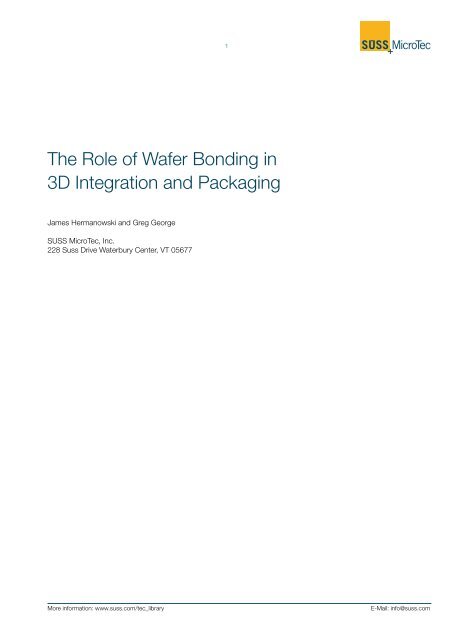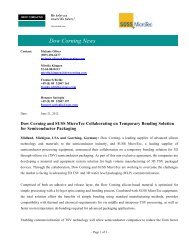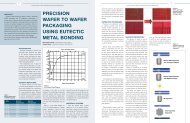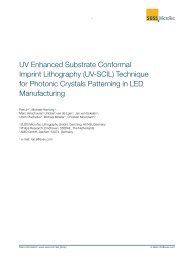The Role of Wafer Bonding in 3D Integration and ... - SUSS MicroTec
The Role of Wafer Bonding in 3D Integration and ... - SUSS MicroTec
The Role of Wafer Bonding in 3D Integration and ... - SUSS MicroTec
You also want an ePaper? Increase the reach of your titles
YUMPU automatically turns print PDFs into web optimized ePapers that Google loves.
<strong>The</strong> <strong>Role</strong> <strong>of</strong> <strong>Wafer</strong> <strong>Bond<strong>in</strong>g</strong> <strong>in</strong><br />
<strong>3D</strong> <strong>Integration</strong> <strong>and</strong> Packag<strong>in</strong>g<br />
James Hermanowski <strong>and</strong> Greg George<br />
<strong>SUSS</strong> <strong>MicroTec</strong>, Inc.<br />
228 Suss Drive Waterbury Center, VT 05677<br />
1<br />
More <strong>in</strong>formation: www.suss.com/tec_library E-Mail: <strong>in</strong>fo@suss.com
2<br />
<strong>The</strong> <strong>Role</strong> <strong>of</strong> <strong>Wafer</strong> <strong>Bond<strong>in</strong>g</strong> <strong>in</strong> <strong>3D</strong> <strong>Integration</strong><br />
<strong>and</strong> Packag<strong>in</strong>g<br />
James Hermanowski <strong>and</strong> Greg George<br />
<strong>SUSS</strong> <strong>MicroTec</strong>, Inc.<br />
228 Suss Drive<br />
Waterbury Center, VT 05677<br />
Abstract<br />
<strong>The</strong>re are numerous process <strong>in</strong>tegration schemes currently <strong>in</strong> place for the implementation <strong>of</strong> <strong>3D</strong>-IC. Via first, via middle, via<br />
last along with back end <strong>of</strong> l<strong>in</strong>e (BEOL), front end <strong>of</strong> l<strong>in</strong>e (FEOL) <strong>and</strong> other variations <strong>of</strong> these approaches. This work will<br />
explore the role <strong>of</strong> wafer bond<strong>in</strong>g, both permanent <strong>and</strong> temporary, <strong>in</strong> the fabrication <strong>of</strong> <strong>3D</strong>-IC. Additionally, the materials <strong>and</strong><br />
process flows used for these processes will be exam<strong>in</strong>ed <strong>in</strong> detail.<br />
I. Introduction<br />
<strong>3D</strong> <strong>Integration</strong> <strong>and</strong> Packag<strong>in</strong>g are currently<br />
described as “paradigm shifts”, “revolutionary<br />
technologies”, <strong>and</strong> other equally prophetic catch<br />
phrases. <strong>The</strong> realization <strong>of</strong> <strong>3D</strong> to meet <strong>and</strong> exceed<br />
these expectations requires significant advances <strong>in</strong><br />
surface preparation methods (CMP – chemical<br />
mechanical polish<strong>in</strong>g), development <strong>of</strong> metal fill<br />
technologies (TSV – through silicon via etch, plat<strong>in</strong>g,<br />
<strong>and</strong> vapor deposition), redistribution layers,<br />
<strong>in</strong>terposer technology, <strong>and</strong> micro bump<strong>in</strong>g methods,<br />
advanced permanent bond<strong>in</strong>g methods, th<strong>in</strong> wafer<br />
h<strong>and</strong>l<strong>in</strong>g (materials, carriers, bond<strong>in</strong>g <strong>and</strong> debond<strong>in</strong>g),<br />
as well as simulators (architectural design to cost <strong>of</strong><br />
ownership model<strong>in</strong>g). <strong>The</strong> complexity <strong>of</strong> <strong>3D</strong><br />
<strong>in</strong>tegration <strong>and</strong> packag<strong>in</strong>g blurs the l<strong>in</strong>e between<br />
process node del<strong>in</strong>eation <strong>and</strong> requires an overall<br />
evaluation <strong>and</strong> underst<strong>and</strong><strong>in</strong>g <strong>of</strong> the entire process<br />
flows. All downstream processes are affected by the<br />
methods used prior to actual <strong>in</strong>tegration process<strong>in</strong>g.<br />
<strong>Wafer</strong> level bond<strong>in</strong>g is a key step, if not the<br />
fundamental step, <strong>in</strong> the success <strong>of</strong> <strong>3D</strong>. If the<br />
stack<strong>in</strong>g <strong>of</strong> the devices is not successful all the<br />
previous <strong>and</strong> subsequent steps are moot.<br />
<strong>The</strong> ultimate goal <strong>of</strong> <strong>3D</strong> is the flow <strong>of</strong> electrical<br />
signals between layers. This can be at the transistor<br />
level between memory layers as <strong>in</strong> <strong>3D</strong> ICs, or it can<br />
be at the packag<strong>in</strong>g level between the various<br />
heterogeneous devices e.g., logic controller to MEMS<br />
device. Permanent wafer bond<strong>in</strong>g methods used <strong>in</strong><br />
<strong>3D</strong> <strong>in</strong>volve metal bond<strong>in</strong>g or hybrid approaches with<br />
metal <strong>and</strong> dielectric layers. <strong>The</strong> most <strong>of</strong>ten used<br />
materials are Cu <strong>and</strong> CuSn for <strong>3D</strong> ICs <strong>and</strong> Au, Al, or<br />
Cu based eutectics for hermetic packag<strong>in</strong>g <strong>and</strong> micro<br />
bump<strong>in</strong>g. <strong>The</strong> process flows, requirements <strong>and</strong><br />
specification requirements for each bond<strong>in</strong>g<br />
technology are based on st<strong>and</strong>ard metrology metrics<br />
but the requirements for high yields are specific for<br />
each technology <strong>and</strong> will be discussed.<br />
Equally essential to the success <strong>of</strong> <strong>3D</strong> <strong>in</strong>tegration<br />
<strong>and</strong> packag<strong>in</strong>g is the ability to reta<strong>in</strong> f<strong>in</strong>al stack<br />
dimensions that meet the application form factor. For<br />
example, it would be unwise to promote vertically<br />
stacked devices that resulted <strong>in</strong> a “chip” that was<br />
several millimeters thick when the applications<br />
require the devices to fit <strong>in</strong>to smaller <strong>and</strong> smaller<br />
spaces. To facilitate stack<strong>in</strong>g, m<strong>in</strong>imize the vertical<br />
<strong>in</strong>terconnect length, <strong>and</strong> achieve form factor<br />
requirements it is common to th<strong>in</strong> each layer <strong>in</strong> the<br />
stack to 50μm or less. <strong>The</strong> development <strong>and</strong> f<strong>in</strong>e<br />
tun<strong>in</strong>g <strong>of</strong> temporary adhesives, the support substrate<br />
options, <strong>and</strong> the quality <strong>of</strong> the debond <strong>and</strong> th<strong>in</strong> wafer<br />
transfer robustness are all advanc<strong>in</strong>g toward high<br />
volume manufactur<strong>in</strong>g options. <strong>The</strong> lead<strong>in</strong>g<br />
technology choices for TWH with compatibility<br />
tables will be provided to assist <strong>in</strong> the selection<br />
process for various types <strong>of</strong> device applications.<br />
II. <strong>Bond<strong>in</strong>g</strong> Sequences for <strong>3D</strong>-IC<br />
<strong>The</strong> n<strong>in</strong>e major <strong>3D</strong>-IC process flows are shown <strong>in</strong><br />
Table 1. In every case, a permanent bond<strong>in</strong>g step is<br />
required to form the <strong>3D</strong>-IC. Almost all <strong>of</strong> the bonds<br />
are metal to metal <strong>and</strong> five out <strong>of</strong> n<strong>in</strong>e <strong>of</strong> the<br />
processes call for temporary bond<strong>in</strong>g to a h<strong>and</strong>le<br />
wafer followed by wafer th<strong>in</strong>n<strong>in</strong>g.<br />
More <strong>in</strong>formation: www.suss.com/tec_library E-Mail: <strong>in</strong>fo@suss.com
TABLE 1. Major <strong>3D</strong>-IC Process Flows<br />
IC<br />
Process <strong>Wafer</strong> Step #1 Step #2 Step #3<br />
A<br />
B<br />
C<br />
D<br />
FEOL<br />
TSV (vias<br />
first)<br />
FEOL<br />
TSV (vias<br />
first)<br />
BEOL<br />
TSV (vias<br />
first)<br />
BEOL<br />
TSV (vias<br />
first)<br />
E No TSV<br />
F No TSV<br />
G No TSV<br />
H No TSV<br />
I No TSV<br />
<strong>Wafer</strong><br />
Th<strong>in</strong>n<strong>in</strong>g<br />
(temp.<br />
h<strong>and</strong>le)<br />
"facedown"<br />
Bond<br />
(metal<br />
bond<strong>in</strong>g)<br />
<strong>Wafer</strong><br />
Th<strong>in</strong>n<strong>in</strong>g<br />
(temp.<br />
h<strong>and</strong>le)<br />
"facedown"<br />
Bond<br />
(metal<br />
bond<strong>in</strong>g)<br />
TSV from<br />
front (vias<br />
first)<br />
TSV from<br />
front (vias<br />
first)<br />
"facedown"<br />
Bond<br />
(all methods)<br />
<strong>Wafer</strong><br />
Th<strong>in</strong>n<strong>in</strong>g<br />
(temp.<br />
h<strong>and</strong>le)<br />
<strong>Wafer</strong><br />
Th<strong>in</strong>n<strong>in</strong>g<br />
(temp.<br />
h<strong>and</strong>le)<br />
"face-up"<br />
Bond (metal<br />
bond<strong>in</strong>g)<br />
<strong>Wafer</strong><br />
Th<strong>in</strong>n<strong>in</strong>g (on<br />
<strong>3D</strong> stack)<br />
"face-up"<br />
Bond (metal<br />
bond<strong>in</strong>g)<br />
<strong>Wafer</strong><br />
Th<strong>in</strong>n<strong>in</strong>g (on<br />
<strong>3D</strong> stack)<br />
"facedown"<br />
Bond<br />
(metal<br />
bond<strong>in</strong>g)<br />
<strong>Wafer</strong><br />
Th<strong>in</strong>n<strong>in</strong>g<br />
(temp.<br />
h<strong>and</strong>le)<br />
<strong>Wafer</strong><br />
Th<strong>in</strong>n<strong>in</strong>g (on<br />
<strong>3D</strong> stack)<br />
"face-up"<br />
Bond (all<br />
methods)<br />
TSV from<br />
back (vias<br />
first)<br />
<strong>Wafer</strong><br />
Th<strong>in</strong>n<strong>in</strong>g (on<br />
<strong>3D</strong> stack)<br />
"face-up"<br />
Bond (metal<br />
bond<strong>in</strong>g)<br />
TSV from<br />
back (vias<br />
last)<br />
TSV from<br />
front (vias<br />
last)<br />
"face-up"<br />
Bond (metal<br />
bond<strong>in</strong>g)<br />
Figure 1 shows <strong>in</strong> graphical form the n<strong>in</strong>e major<br />
<strong>3D</strong>-IC process flows. [1]<br />
A&C<br />
B&D<br />
E<br />
Figure 1. <strong>The</strong> n<strong>in</strong>e major process sequences for<br />
<strong>3D</strong>-IC.<br />
III. Primary Metal Schemes Used for <strong>Bond<strong>in</strong>g</strong><br />
<strong>The</strong> selection <strong>of</strong> metal <strong>in</strong>terconnect between two<br />
wafers is <strong>of</strong>ten a byproduct <strong>of</strong> the metals used <strong>in</strong> the<br />
metal wir<strong>in</strong>g <strong>of</strong> the <strong>in</strong>dividual chips. Copper <strong>and</strong><br />
F<br />
G<br />
Temporary <strong>Bond<strong>in</strong>g</strong><br />
Align<strong>in</strong>g <strong>and</strong> <strong>Bond<strong>in</strong>g</strong> (Permanent)<br />
Source: Phil Garrou, MCNC 2008<br />
H<br />
I<br />
3<br />
copper-t<strong>in</strong> are lead<strong>in</strong>g choices due to the wide<br />
availability <strong>of</strong> copper processes <strong>in</strong> wafer fabs. Copper<br />
to copper (Cu-Cu) bond<strong>in</strong>g is a diffusion based<br />
process while copper-t<strong>in</strong> (CuSn-Cu) bond<strong>in</strong>g is a<br />
eutectic type. Table 2 shows various metal bond<strong>in</strong>g<br />
schemes.<br />
TABLE 2. Comparison <strong>of</strong> Metal <strong>Bond<strong>in</strong>g</strong> Schemes<br />
ReactionType Metal Bond<br />
Temp<br />
Diffusion<br />
Eutectic<br />
Cu-Cu >350°C Yes<br />
Au-Au >300°C No<br />
Al-Ge >419°C Yes<br />
AuSi >363°C No<br />
AuGe >361°C No<br />
AuSn >278°C No<br />
CuSn >231°C Yes<br />
CMOS<br />
Compatible<br />
Diffusion bond<strong>in</strong>g has str<strong>in</strong>gent surface<br />
roughness <strong>and</strong> flatness requirements. It is known that<br />
for diffusion bond<strong>in</strong>g, the contact area <strong>and</strong> bond<strong>in</strong>g<br />
energy must be as large as possible. It is therefore<br />
important for the two mat<strong>in</strong>g metal surfaces to be<br />
very smooth <strong>and</strong> flat to allow for solid state diffusion.<br />
<strong>The</strong> surface roughness <strong>of</strong> the substrate <strong>in</strong> addition to<br />
its activation state def<strong>in</strong>es the temperature <strong>and</strong> the<br />
force required for good bond<strong>in</strong>g. It has been<br />
demonstrated that the surface roughness affects the<br />
bond<strong>in</strong>g quality when the bond<strong>in</strong>g temperature is low.<br />
<strong>The</strong> typical reported micro-roughness values <strong>of</strong><br />
sputtered Cu on (300nm) on Ta (100nm) range from<br />
1.5 to 2nm. Low temperature bond<strong>in</strong>g processes<br />
(
diffusion at temperatures as low as 200°C us<strong>in</strong>g a<br />
self-assembled monolayer approach or at room<br />
temperature after ion sputter clean<strong>in</strong>g.<br />
For Cu eutectic wafer bond<strong>in</strong>g, the surface<br />
micro-roughness is not as important. <strong>The</strong>re is<br />
significant <strong>in</strong>dustry experience from solder jo<strong>in</strong>t<br />
studies relat<strong>in</strong>g to chip packag<strong>in</strong>g that <strong>in</strong>dicates this<br />
bond approach is also less sensitive to surface<br />
contam<strong>in</strong>ation[4]. <strong>The</strong> lower process<strong>in</strong>g temperature<br />
also makes it friendlier for wafer process<strong>in</strong>g thermal<br />
budgets.<br />
Si<br />
Interface Cu<br />
Interface<br />
Cu<br />
Si<br />
1μm<br />
Fig. 2. Cu-Cu bond <strong>in</strong>terface show<strong>in</strong>g gra<strong>in</strong><br />
boundary.<br />
2-4µm Gra<strong>in</strong>s<br />
with subgra<strong>in</strong><br />
high angle<br />
gra<strong>in</strong><br />
boundaries.<br />
complete delam<strong>in</strong>ation <strong>of</strong> the th<strong>in</strong>ned wafer from the<br />
carrier; areas where pockets <strong>of</strong> the th<strong>in</strong>ned wafer<br />
delam<strong>in</strong>ate <strong>in</strong> the form <strong>of</strong> centimeter sized bubbles,<br />
see figure 4; <strong>and</strong> “flowers” where the th<strong>in</strong>ned wafer<br />
exhibits millimeter sized flower shaped defects [7].<br />
<strong>The</strong>rmal performance measurements should predict<br />
the formation <strong>of</strong> these defects.<br />
Differential pressure <strong>and</strong><br />
adhesive decomposition<br />
caus<strong>in</strong>g gas pocket.<br />
<strong>The</strong>rmo-gravimetric analysis (TGA) is a simple<br />
tool useful for compar<strong>in</strong>g different adhesives. TGA<br />
can be used to narrow the selection <strong>of</strong> an adhesive<br />
but it does not reveal the materials that evolve dur<strong>in</strong>g<br />
thermal process<strong>in</strong>g. <strong>The</strong>rmal desorption spectroscopy<br />
(TDS) or thermal extraction with mass spectrometer<br />
(TEDGCMass) can provide detailed <strong>in</strong>formation<br />
relat<strong>in</strong>g to the relative quantity <strong>and</strong> types <strong>of</strong><br />
compounds evolved dur<strong>in</strong>g thermal process<strong>in</strong>g. This<br />
<strong>in</strong>formation can be useful for even more detailed<br />
comparison <strong>of</strong> adhesives as well as predict<strong>in</strong>g the<br />
potential impact on the process equipment exposed to<br />
these compounds, for example, clean<strong>in</strong>g frequency.<br />
However, these measurements should be <strong>in</strong>terpreted<br />
carefully as they do not represent the actual use <strong>of</strong> the<br />
polymer where it is s<strong>and</strong>wiched between two wafers.<br />
VI. Adhesive Systems<br />
Th<strong>in</strong>ned wafer<br />
Adhesive<br />
Carrier wafer<br />
Figure 4. Adhesive decomposition <strong>and</strong> adhesive<br />
vapor pressure dur<strong>in</strong>g high temperature, high<br />
vacuum process<strong>in</strong>g lead<strong>in</strong>g to gas pocket.<br />
<strong>The</strong>re are three ma<strong>in</strong> th<strong>in</strong> wafer h<strong>and</strong>l<strong>in</strong>g<br />
adhesive systems which allow debond<strong>in</strong>g after tape<br />
frame mount<strong>in</strong>g: 3M <strong>Wafer</strong> Support System<br />
adhesive system [8], Th<strong>in</strong> Materials AG adhesive<br />
system (T-MAT) [9], <strong>and</strong> Brewer Science Inc.ʼs<br />
ZoneBOND system [10]. As a po<strong>in</strong>t <strong>of</strong> reference, one<br />
thermal-slide process will be shown [11].<br />
A. Brewer Science, Inc. <strong>Wafer</strong>BOND HT10.10<br />
Brewerʼs material uses an adhesive cast <strong>in</strong><br />
solvent which is sp<strong>in</strong> coated <strong>and</strong> baked much like<br />
photoresist. <strong>Bond<strong>in</strong>g</strong> is done <strong>in</strong> a vacuum chamber at<br />
moderate force (
<strong>The</strong> key characteristics <strong>of</strong> the 3M process <strong>in</strong>clude<br />
room temperature debond<strong>in</strong>g <strong>and</strong> debond<strong>in</strong>g after<br />
frame mount<strong>in</strong>g.<br />
3M: Materials/Process<br />
Temporary Bond<br />
Device <strong>Wafer</strong><br />
Glass Carrier<br />
<strong>Wafer</strong><br />
Debond<br />
Th<strong>in</strong>ned Device<br />
<strong>Wafer</strong><br />
Carrier <strong>Wafer</strong><br />
C. Th<strong>in</strong> Materials AG (T-MAT)<br />
T-MATʼs process uses a precursor spun on to the<br />
CMOS wafer. This is then converted via a simple PE-<br />
CVD process to form a release layer ~100 – 150nm<br />
thick. <strong>The</strong> elastomer used is a high temperature<br />
material cured at ~180°C which jo<strong>in</strong>s the wafer to the<br />
carrier. Debond<strong>in</strong>g can occur after the wafer stack is<br />
attached to a tape frame with the th<strong>in</strong>ned wafer<br />
attached to the tape. One vacuum chuck is used to<br />
hold the th<strong>in</strong>ned wafer via the taped side while<br />
another holds the carrier. Upon slight separation <strong>of</strong><br />
the stack at one side, a debond wave moves across<br />
the stack separat<strong>in</strong>g the wafers <strong>and</strong> leav<strong>in</strong>g beh<strong>in</strong>d<br />
the th<strong>in</strong>ned wafer supported by the tape/frame. <strong>The</strong><br />
process is shown <strong>in</strong> figure 7.<br />
Th<strong>in</strong> Materials AG: Materials/Process<br />
Temporary Bond<br />
Device <strong>Wafer</strong><br />
Carrier <strong>Wafer</strong><br />
Debond<br />
Th<strong>in</strong>ned Device<br />
<strong>Wafer</strong><br />
Attached to<br />
Dic<strong>in</strong>g Frame<br />
Sp<strong>in</strong> Coat<br />
Adhesive<br />
Sp<strong>in</strong> Coat LTHC<br />
Sp<strong>in</strong> Coat<br />
Precursor<br />
Sp<strong>in</strong> Coat<br />
Elastomer<br />
Precision Align <strong>and</strong><br />
Permanent Bond<br />
Carrier <strong>Wafer</strong> Attached to<br />
Dic<strong>in</strong>g Frame<br />
Device <strong>Wafer</strong><br />
with Adhesive<br />
Carrier <strong>Wafer</strong> with<br />
LTHC Coat<strong>in</strong>g<br />
Plasma Form<br />
Release Layer<br />
<strong>3D</strong> Stacked<br />
<strong>Wafer</strong>s<br />
Remove Carrier<br />
B. Brewer Science Inc., ZoneBOND<br />
Flip <strong>Wafer</strong><br />
Flip <strong>Wafer</strong><br />
UV Light<br />
Bond <strong>and</strong> UV<br />
Cure Adhesive<br />
Laser Release Remove Carrier Peel Adhesive<br />
Figure 6. 3M WSS process flow.<br />
R<strong>in</strong>se<br />
Temporary Bond<br />
Processed <strong>Wafer</strong><br />
on Frame<br />
Temporary Bond<br />
Figure 7. Typical T-MAT process flow.<br />
Processed<br />
<strong>Wafer</strong> on Frame<br />
6<br />
ZoneBOND uses a specially prepared carrier<br />
with two dist<strong>in</strong>ct zones as shown <strong>in</strong> Figure 8. <strong>The</strong><br />
edge zone consists <strong>of</strong> a normal silicon wafer while<br />
the center zone exhibits low adhesion properties. <strong>The</strong><br />
carrier is then bonded to the device wafers us<strong>in</strong>g heat<br />
<strong>and</strong> force.<br />
Debond<strong>in</strong>g is a multiple step process whereby<br />
the first step removes the adhesive jo<strong>in</strong><strong>in</strong>g the wafer<br />
<strong>and</strong> carrier at the edge. <strong>The</strong> second step is a<br />
mechanical wedge separation <strong>of</strong> the carrier from the<br />
wafer by a means very similar to TMAT. <strong>The</strong> f<strong>in</strong>al<br />
step is the removal <strong>of</strong> the adhesive from the face <strong>of</strong><br />
the device wafer.<br />
<strong>The</strong> key characteristics <strong>of</strong> BSIʼs ZoneBOND<br />
process <strong>in</strong>clude room temperature debond<strong>in</strong>g <strong>and</strong><br />
debond<strong>in</strong>g after frame mount<strong>in</strong>g.<br />
Brewer Science Inc., ZoneBOND<br />
Figure 8. Typical process for BSI ZoneBOND<br />
VII. Mechanical Properties<br />
Aga<strong>in</strong>, five <strong>of</strong> the n<strong>in</strong>e <strong>3D</strong>-IC process flows call<br />
for the transfer <strong>of</strong> the th<strong>in</strong>ned wafer supported by the<br />
carrier to another wafer us<strong>in</strong>g permanent bond<strong>in</strong>g.<br />
Mechanical hardness <strong>of</strong> the temporary adhesive must<br />
hold the th<strong>in</strong>ned wafer flat to the carrier dur<strong>in</strong>g high<br />
temperature process<strong>in</strong>g. If the adhesive gives dur<strong>in</strong>g<br />
the bond process, the th<strong>in</strong> wafer will flex under<br />
pressure from the bond<strong>in</strong>g po<strong>in</strong>ts as shown <strong>in</strong> Figures<br />
9a <strong>and</strong> 9b. If these process flows are expected to be<br />
utilized then thermo-mechanical analysis test<strong>in</strong>g<br />
should be conducted to ensure suitable hardness<br />
dur<strong>in</strong>g the process conditions.<br />
Delam<strong>in</strong>ation <strong>of</strong> the wafer from the carrier is not<br />
normally an issue for these processes. In fact, it is<br />
desired for the th<strong>in</strong> device wafer to delam<strong>in</strong>ate or<br />
debond from the carrier while it is bonded to another<br />
wafer. In this case, the process might be considered a<br />
layer transfer. In the case <strong>of</strong> TMATʼs adhesive<br />
system, this has been demonstrated <strong>and</strong> will likely<br />
More <strong>in</strong>formation: www.suss.com/tec_library E-Mail: <strong>in</strong>fo@suss.com
work as well with other silicone based adhesive<br />
systems. More <strong>of</strong>ten the adhesive will change under<br />
the heat <strong>and</strong> pressure <strong>of</strong> the permanent bond process<br />
<strong>and</strong> not allow debond<strong>in</strong>g later or the adhesive will<br />
become too difficult to remove by normal means.<br />
<strong>Wafer</strong> to be<br />
bonded<br />
Th<strong>in</strong>ned wafer<br />
Adhesive<br />
Carrier wafer<br />
<strong>Wafer</strong><br />
Th<strong>in</strong>ned wafer<br />
Adhesive<br />
Carrier wafer<br />
Figure 9a. <strong>Wafer</strong>s before bond<strong>in</strong>g.<br />
Compressed<br />
VIII. Summary <strong>and</strong> Conclusions<br />
3000A<br />
Cu posts<br />
3000A<br />
Cu posts<br />
Unbonded<br />
posts<br />
Figure 9b. Th<strong>in</strong> wafer after bond<strong>in</strong>g show<strong>in</strong>g<br />
deformation due to lack <strong>of</strong> support from adhesive<br />
at high temperatures.<br />
<strong>Wafer</strong> bond<strong>in</strong>g has an important role <strong>in</strong> <strong>3D</strong>-IC<br />
applications. <strong>Wafer</strong> bond<strong>in</strong>g, permanent or<br />
temporary, is an essential requirement <strong>and</strong> the only<br />
viable means to achieve cost effective chips.<br />
Permanent bond<strong>in</strong>g is used <strong>in</strong> all process flows while<br />
temporary bond<strong>in</strong>g is also used <strong>in</strong> over half <strong>of</strong> the<br />
process flows.<br />
Copper based processes dom<strong>in</strong>ate for permanent<br />
bond<strong>in</strong>g as copper is readily available <strong>in</strong> wafer fabs<br />
globally. However, copper bond<strong>in</strong>g is susceptible to<br />
defects <strong>and</strong> degradation caused by surface<br />
contam<strong>in</strong>ation from oxides <strong>and</strong> organics. Elim<strong>in</strong>at<strong>in</strong>g<br />
<strong>and</strong> controll<strong>in</strong>g these impurities is imperative for <strong>3D</strong>-<br />
IC Cu bond<strong>in</strong>g processes.<br />
<strong>The</strong> lead<strong>in</strong>g temporary bond<strong>in</strong>g adhesives use a<br />
process flow that allows debond<strong>in</strong>g after mount<strong>in</strong>g to<br />
a tape frame. <strong>The</strong> taught tape on the frame provides a<br />
necessary <strong>and</strong> sound surface for support<strong>in</strong>g the<br />
7<br />
th<strong>in</strong>ned wafer. Traditional thermal-slide <strong>and</strong> solvent<br />
debond processes do not allow debond<strong>in</strong>g after<br />
mount<strong>in</strong>g to a tape frame limit<strong>in</strong>g debond yield <strong>and</strong><br />
m<strong>in</strong>imum wafer thickness.<br />
<strong>The</strong> desired properties for temporary adhesives<br />
are extremely challeng<strong>in</strong>g. An approach to quantify<br />
thermal performance <strong>of</strong> temporary adhesives at high<br />
temperatures us<strong>in</strong>g TGA <strong>and</strong> TDS data has been<br />
presented. <strong>The</strong> approach provides a good predictor <strong>of</strong><br />
the complex processes that occur at high<br />
temperatures.<br />
REFERENCES<br />
[1] Phil Garrou, MCNC 2008<br />
[2]Chuan Seng Tan,Dau Fatt Lim, Shiv Gov<strong>in</strong>d S<strong>in</strong>gh, Sarah<br />
Goulet, <strong>and</strong> Magnus Bergkvist. (2009). Cu-Cu diffusion<br />
bond<strong>in</strong>g enhancement at low temperature by surface<br />
passivation us<strong>in</strong>g self-assembled monolayer <strong>of</strong> alkane-thiol.<br />
Applied Physics Letters, 95(19).<br />
[3] T. H. Kim, M. M. R. Howlader, T. Itoh, <strong>and</strong> T. Suga,<br />
“Room temperature Cu/Cu direct wafer bond<strong>in</strong>g us<strong>in</strong>g surface<br />
activated bond<strong>in</strong>g method", Journal <strong>of</strong> Vacuum Science <strong>and</strong><br />
Technology A21(2) (2003) 449-453.<br />
[4] Raiyo Asp<strong>and</strong>iar, Voids <strong>in</strong> Solder Jo<strong>in</strong>ts, SMTA Northwest<br />
Chapter Meet<strong>in</strong>g, September 21, 2005.<br />
[5] James Hermanowski, “Th<strong>in</strong> <strong>Wafer</strong> H<strong>and</strong>l<strong>in</strong>g – Study <strong>of</strong><br />
Temporary <strong>Wafer</strong> <strong>Bond<strong>in</strong>g</strong> Materials <strong>and</strong> Processes”<br />
Proceed<strong>in</strong>gs <strong>of</strong> <strong>3D</strong> System <strong>Integration</strong>, 2009. <strong>3D</strong> System<br />
<strong>Integration</strong>, 2009. <strong>3D</strong>-IC 2009 IEEE International Conference<br />
on <strong>3D</strong> <strong>Integration</strong>.<br />
[6] J. Charbonnier, S. Cheramy, D. Henry, A. Astier, J. Brun,<br />
N. Sillon, et al., “<strong>Integration</strong> <strong>of</strong> a Temporary Carrier <strong>in</strong> a TSV<br />
Process Flow,” Electronics Components <strong>and</strong> Technology<br />
Conference, 2009<br />
[7] Tony Flaim, “Ultrath<strong>in</strong> <strong>Wafer</strong> H<strong>and</strong>l<strong>in</strong>g,” <strong>3D</strong> Architectures<br />
Conference, November 2008<br />
[8] 3M WSS product documentation<br />
[9] Th<strong>in</strong> Materials AG product documentation<br />
[10] Jeremy McCutchen, ZoneBOND Th<strong>in</strong> <strong>Wafer</strong> Support<br />
Process for Temporary <strong>Wafer</strong> <strong>Bond<strong>in</strong>g</strong> Applications,<br />
Proceed<strong>in</strong>gs <strong>of</strong> IMAPS 6 th International Conference on Device<br />
Packag<strong>in</strong>g, March 2010.<br />
[11] Brewer Science Inc. product documentation<br />
[12] US patent application 20050233547<br />
[13] S. Pillalamarri, R. Puligadda, C. Brubaker, M.<br />
Wimpl<strong>in</strong>ger, S. Pargfrieder, “High Temperature Sp<strong>in</strong>-On<br />
Adhesives for Temporary <strong>Wafer</strong> <strong>Bond<strong>in</strong>g</strong>,” Journal <strong>of</strong><br />
Microelectronics <strong>and</strong> Electronic Packag<strong>in</strong>g, 2007 vol. 4<br />
[14] S. Farrens, P. L<strong>in</strong>dner, S. Dwyer, M. Wimpl<strong>in</strong>ger,<br />
“Beg<strong>in</strong>n<strong>in</strong>g-to-end wafer bond<strong>in</strong>g for advanced optical<br />
systems,” SPIE, vol. 5177, 2003<br />
More <strong>in</strong>formation: www.suss.com/tec_library E-Mail: <strong>in</strong>fo@suss.com





